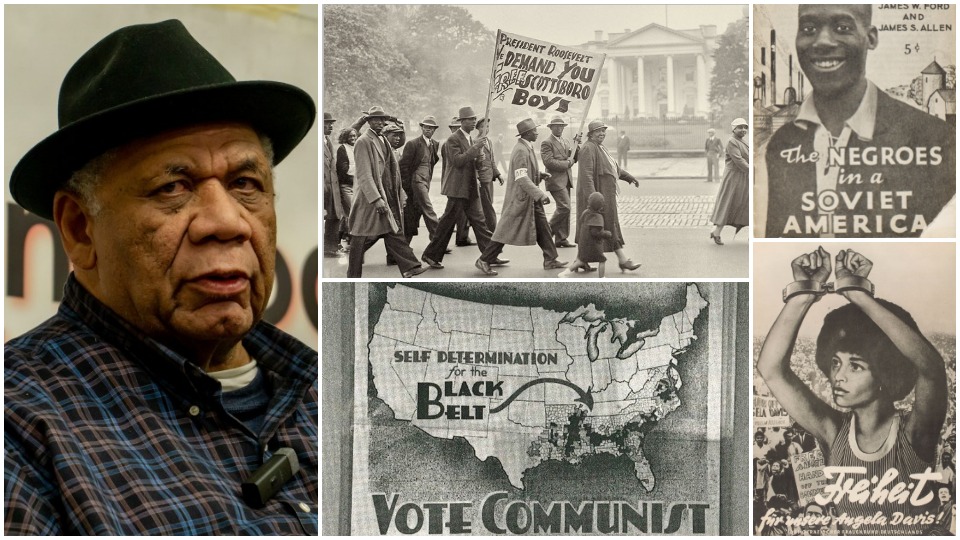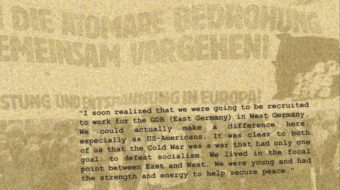
Frank Chapman has a long and storied reputation as an activist-leader-theoretician in the anti-repression, labor, and left movements. His history makes it imperative that activists engage with his theoretical work, which is drawn from years of struggle in the mass movement. His latest book, Marxist-Leninist Perspectives on Black Liberation and Socialism, traces the history of the developments and interconnections between the struggle for socialism and the African American freedom movement.
Chapman’s thesis is that “the revolutionary content of Marxism-Leninism lies precisely in seeing the centrality of the national question in the struggle against imperialism and the struggle for socialism.” (p. 7) (One may contest whether, in general, that is the “revolutionary content” of Marxism-Leninism, but it is indisputable that Lenin’s analysis of the relationship between the socialist revolution and the national/colonial struggle to the world revolutionary process is critical—of that, there is no doubt.)
In early chapters, Chapman examines the development of the African American movement and the broader movement of the working class through the growth of capitalism in the U.S., the American revolution, slavery, and Reconstruction. He also examines early African American freedom movements that sought equality and/or separation on lands based in Africa or the Caribbean.
In Chapman’s retelling, the 1919 founding of the Communist Party USA created (with the assistance of the Communist International) the basis of a theoretical framework to solidify the relationship between the struggle for socialism and the struggle for Black liberation through the application of the nationalities question. Chapman traces the development of the idea of African American oppression as being an aspect of the “national question” through the work of African American and Afro-Caribbean activists in the African Blood Brotherhood and the writings of Lenin and Stalin.
The Sixth Congress of the Communist International (1928) put forth a resolution that mandated the U.S. Communist Party recognize the legitimacy of the African American movement. In Chapman’s summation, it called upon the U.S. party to “implement a program calling for complete and real equality, for the elimination of every kind of racial, social, and political inequality.” (p. 113). The resolution also made it clear that African American oppression was a “national question” and that African Americans were an oppressed nation within the boundaries of the Black Belt South, where they made up the majority of the population, and that the area was entitled to the right of self-determination.
Chapman also details how Communist and leftist African Americans, in alliance with foreign communists who were familiar with the U.S., including the Japanese Communist Sen Katayama, played a major role in getting the Communist International to focus on the African American question.
Chapman argues that this new theoretical framework laid the basis for the Communist Party to concentrate activities within the African American community. Throughout this period, the party organized sharecroppers and industrial workers in the Black Belt South, and ratcheted up its efforts in opposing discrimination and racism throughout the country. This is the period when the Communist Party earned the sobriquet, “the party of the Negro people.”
Chapman concludes by noting: “It was not by some ingenious device for recruiting or brilliant propaganda strategy that the Communist Party gained so much ground with Black people in the deep South. Communists gained so much ground because they were programmatically and concretely addressing the most elemental demands of the struggle for Black Liberation.” He adds that the Communist Party “recognized the existence of the Black Nation” and “joined in the class struggle and the struggle for Black Liberation on the ground.” (p. 178).
The Communist Party dropped the “Self-Determination for the Black Belt” position in 1944-45, under the leadership of then-General Secretary Earl Browder. In part, this was viewed as an aspect of the party’s Popular Front strategy. But many party members identified “Browderism” with the critique of the “Black Belt Thesis” and after Browder’s expulsion in 1945, the position was re-adopted. A years-long theoretical debate within the Communist Party about the “Self-Determination for the Black Belt” position ensued.
That debate was concluded in 1959 with the publication of James E. Jackson’s Theoretical Aspects of the Negro Question in the United States. Jackson argued that:
“To conclude that the Negro people in the U.S. are not a nation is not to say that the Negro question in our country is not a national question. It is indeed a national question. The question is, however, a national question of what type, with what distinguishing characteristics, calling for what strategic concept for its solution…
“The national question exists in an infinite variety of forms and manifestations. Within the scope of the national question, there is included not merely the question of the nation, but also the question of national minorities, national and ethnic groups, national-ethnic minorities, national-communal (religious) groups, etc.”
There are three major areas of Chapman’s thesis that deserve more discussion.
First, Chapman’s thesis implies there is a single identification of self-determination as the solution to a national question—as opposed to recognizing that national questions have a multitude of possible solutions within a Marxist-Leninist framework. This was demonstrated in practice by the Soviet Union’s approach to its own nationalities question.
Secondly, his conclusion that the “Self-Determination for the Black Belt” position was the cause of the party’s increased activity in the African American community—as opposed to the causal factor being the party’s identification of the African American question as a national question alongside a further elaboration of the relationship between the national and class struggles—merits further analysis.
While it is indisputable that the party’s theoretical position on the African American question as a “national question” was the major factor that spurred its activities in the African American community, it’s not at all clear that the call for “self-determination” was the causal factor for its successes.
For example, the Southern Negro Youth Congress (1937-49) engaged in heroic work in the South—organizing for voting rights, labor rights, and against repression. This movement provided the background for the Civil Rights Movement that would sweep the South a decade later. Rarely did SNYC ever mention self-determination in their work or literature. The Civil Rights Congress (1946-56) too did yeoman’s work against lynching and repression in the South, but also rarely mentioning self-determination.
Later, there were the movements to Free Angela Davis, building the anti-apartheid movement (NAIMSAL), etc.—all based upon Jackson’s conception of the national question. That is, they viewed the African American question within the context of a national question, lending the term “centrality” to theoretically connect it to the broader class struggle.
This was initially outlined in Jackson’s Theoretical Aspects. Jackson’s aim was to offer a theoretical connection between the class struggle (to overthrow capitalism) and the struggle against racism and for equality. His point was that the overthrow of capitalism was contingent upon the unity of the working class and that that unity had to be constructed on the basis of opposition to racism and to the advocation of equality. This theory was encapsulated by the term “centrality,” which was interpreted as meaning that the struggle against racism and for equality was central to the successful prosecution of the class struggle.
Third, Chapman does not engage with the more recent developments of Marxist-Leninist theory on the national question.
It is important to note that Marxism-Leninist theory on the national question did not end with Lenin and Stalin. In the many decades since these two leaders left the scene, Marxist-Leninists have strengthened the discussion of the national question—based on the developing national liberation movements, the role of national minorities in capitalist countries, and the Soviet experience of building socialism in a multinational republic.
The most exhaustive overall view of these developments is captured in Leninism and the National Question, written by the Institute of Marxism-Leninism (CC CPSU) and published by Progress Publishers in 1977. In a section on “Nationalities, National and Ethnic Groups,” the authors note: “Despite rudiments of industry and the inception of a national bourgeoisie, a working class and intelligensia, their degree of unity and aggregate strength are usually insufficient for the present-day capitalist nationalities to turn into nations. Sometimes, their capacity for independent national existence does not even come into evidence. And where it does awaken partly, the conditions for its materialization in national development are not always available. This applies, among others, to the Negro nationality in the United States.” (page 46).
Thus, the formation of viable nations cannot be reduced to a question of a demographic majority. This is not to say that one should adopt the “Soviet” position uncritically. However, shouldn’t this line of argument be engaged in any discussion of the national question in the U.S.?
In a 2019 article on the Communist Party’s website, contemporary CPUSA leaders Joe Sims and Jarvis Tyner, note:
“That the African Americans constitute a national question is not tantamount to arguing that we constitute a nation…. Why use the term ‘national minorities’? Because ‘oppressed nations’ in Marxist terms constitute a different social entity. ‘Nations’ are defined as peoples who share a common, language, economy, territory, psychological make up, and common culture. A common economic life and territory obviously did not obtain in the African American experience, rendering the classic definition inoperable, particularly after the great migration of six million black souls to work in the industrial Midwest and North in the early part of the 20th century. Two of the five categories delineated above, a common language and psychological make up, were not sufficient to define black Americans as a nation.”
Chapman has written a book that everyone engaged at the intersection of the class struggle and the struggle for equality in the U.S. should read. He successfully highlights the interconnection of theory (the national question) and practice and highlights the role of African American activists and non-U.S. Marxists in elaborating the theory of African American oppression as a national question.
He also succeeds in explaining the history of the U.S. Communist movement’s engagement with the African American question and raises issues and questions which the Communist movement must resolve. These areas of discussion must be conducted among activists in the movement.
Although there will not be immediate agreement on these issues, all engaged can agree on the importance of the struggle for African American freedom. At the end of the day, these issues will be resolved through that struggle. The current fight for community control of police, against employment discrimination, and for expanded voting rights (among other issues) will ultimately be the terrain on which these theoretical issues are resolved.
Marxist-Leninist Perspectives on Black Liberation and Socialism
By Frank Chapman
Freedom Road Socialist Organization, 2021
Available from:
FRSO
P.O. Box 582564
Minneapolis, MN 55458
and Penguin Bookshop












Comments